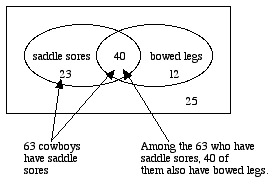EXAMPLE 3.5.1**
According to a recent article from the New England Journal of Medical Stuff ,
63% of cowboys suffer from saddle sores,
52% of cowboys suffer from bowed legs,
40% suffer from both saddle sores and bowed legs.
What is the probability that a randomly selected cowboy has saddle sores and bowed
legs?
Let's answer this question correctly, using the Multiplication Rule.
SOLUTION
Let E be the event that a cowboy has saddle sores. Let F be the event that a cowboy has bowed legs. We are trying to find P(E and F), for two dependent events (a cowboy with saddle sores is more likely to also have bowed legs).
![]()
In this expression, we know that P(E) = .63 (63% of the cowboys have saddle sores).
We need to know P(F, given E); that is, we need to know the probability that a cowboy has bowed legs, given that he has saddle sores. The following Venn diagram can help:

This shows that the probability that a cowboy has bowed legs, given that he has saddle sores [P(F, given E)] is 40/63.
Now we can use the Multiplication Rule correctly:
![]()
The Multiplication Rule will always yield the correct result, as long as we take into account whether the events are dependent or independent.